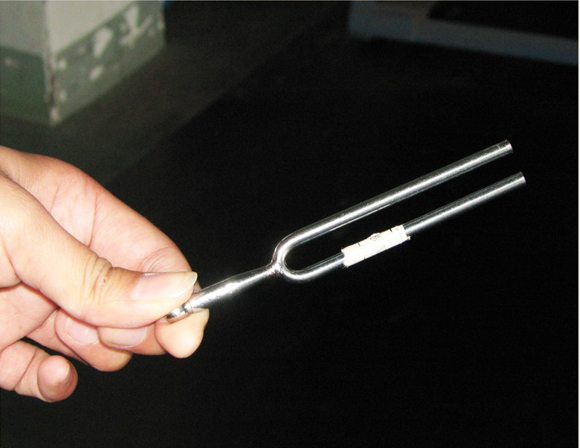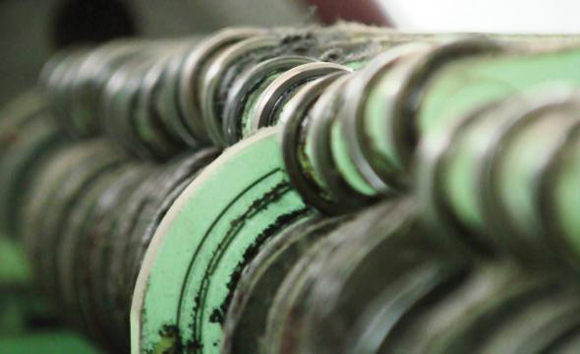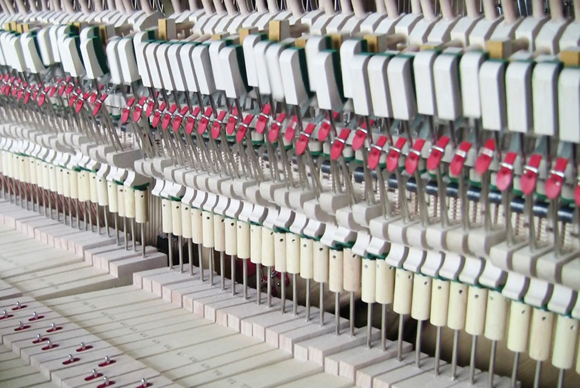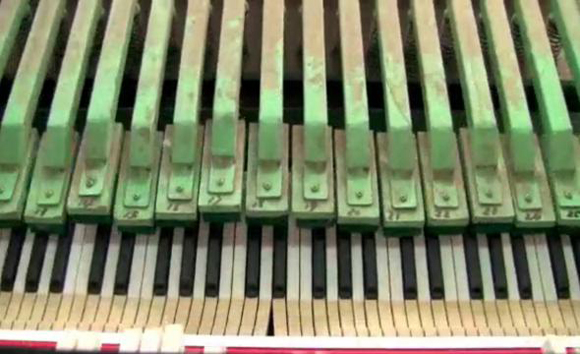Currently on view: Montréal
Euan MacDonald “9,000 Pieces”
at Silver Flag Projects, 21 May – 18 June 2011
Courtesy of the artist.
Silver Flag Projects presents “9,000 pieces†by Euan MacDonald, a looping five and a half minutes single channel HD video projection, which meticulously documents a piano operated by a testing machine. The test performs a short sequence, so-called “repetition and responsiveness testingâ€, one of the final stages in the assembly line of a musical instrument factory, situated on the outskirts of Shanghai, China.
MacDonald’s video is largely composed of close-up piano parts, nine thousand to be precise, aptly indicated for us form the piece’s title. This volume of elements forming the completed piano interacts with what seems an equal quantity of testing machine parts, all moving in a synchronised mechanical ballet. The filmic sequence begins somewhat mysteriously, with a hand pressing a big green “ON†button, followed by a digital display counting time. Extreme close-ups of rotating crankshaft, coiled springs, and spinning things challenge the viewer to grasp the sense of scale of this contraption, which doesn’t yet reveal enough to understand it as a musical instrument. Dozens of thick green metal bars continue their frenzied motion, and metal legs oscillate mercilessly, all under incessant cacophonic noise.
“9,000 Pieces (video still)” (2011) Courtesy of the artist.
Surely a disquieting experience is this soundtrack of accelerating, repetitive and syncopated sounds, which provide few suggestions of where they are coming from within the machine. But as the video progresses, the camera slowly displays wider and wider shots, disclosing more hints as to the instrument’s true identity. From rows of hammers and mufflers, stretched copper wires, ebony and ivory keys encased in a lacquered body, appears the upright piano. Finally when the digital clock reaches 60, the whole commotion ceases as quickly as it started, only leaving a residual melodic tone in the air, of not yet silent piano strings reverberating in the distance.
“9,000 Pieces (video still)” (2011) Courtesy of the artist.
Suspending our knowledge of the utilitarian purposes of the testing apparatus, MacDonald conducted the editing of his video in a fragmentary way, queuing up each fixed camera shot in the systematic order of assembly line logic. With “9,000 pieces†the artist flirts with issues of mass production and globalized socio-economics, but ultimately suggests a deeper reflection upon the undefined areas between order and disorder, circularity and linearity as well as detachment and connection.
“9,000 Pieces (video still)” (2011) Courtesy of the artist.
Visual and sonic elements operate in both interconnected and paradoxical ways with MacDonald’s film. The music is clanging all over the place, but because of how pianos are constructed, its notes still conform to an ordered chromatic scale. It’s impossible to play between two notes on a piano, unlike violins for example which produce more discrete tonal intervals as a musician’s fingers slides down the strings. Only the speed at which the keys are hit here make the individual notes unrecognisable, culminating in polyphonic disorder. One easily associate this to serial music, such as the opening bars of “Different Train†by Steve Reich, performed by a string quartet. Similarly, the experience of continuously moving images bring on a rush of vertigo, which persist from our first glimpse of what could be the insides of a very clean engine, to a general scope of the two boxes caught in embrace, at the end of the video loop sequence.
“9,000 Pieces (video still)” (2011) Courtesy of the artist.
Interestingly the exhibition literature informs us that the test sequence is meant to encapsulate the type of pressures a piano would endure in a whole lifetime, compressed within the period of a single minute. This is laterally similar to the initiation rituals of youths in traditional societies, the musical instrument here performing a double ordeal: a final examination bringing closure to its time in the factory, but also a first substantiation of the piano’s ability to fulfill its role in the outside world.
Courtesy of the artist.
“9,000 Pieces†was originally commissioned by and currently also on view at Yerba Buena Center for the Arts (YBCA ) in San Francisco through 12 June 2011, accompanied with the catalogue of the same title, published also by YBCA. The catalogue is available at Silver Flag Projects during the exhibition.
Euan Macdonald, was born in Edinburgh, Scotland, 1965, and moved to Edmonton with his family as an adolescent. He studied at the Alberta College of Art in Calgary, and the Ontario College of Art in Toronto. He has had numerous solo shows in international museums and galleries including Contemporary Art Gallery, Vancouver; Blackwood Gallery, University of Toronto; Kunstbunker Kinstverein, Nuremberg; and University Art Museum, Long Beach; as well as major group shows, Treble, 2004, Sculpture Center, Queens, NY; Irreducible, 2005, The Wattis Center for Contemporary Art, San Francisco; Seville Biennale, 2004; Gimme Shelter, Museo Tamayo, Mexico City; Fresh, 2000, The New Museum of Contemporary Art, NY; and 010101: Art in Technological Times, SFMOMA, 2001. The artist is represented by Galleria S.A.L.E.S.. He lives and works in Los Angeles.
by M-KOS







Euan Macdonald is currently showing its work at the hayward, London. http://www.bealondoner.com/fr/blog/nadege/euan-macdonald-a-la-hayward-gallery